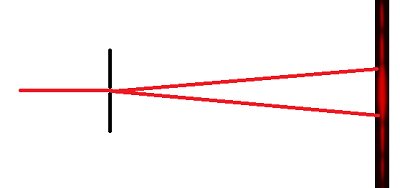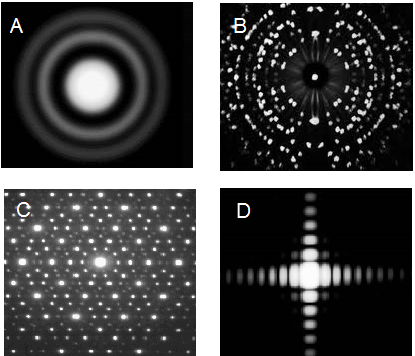MCQs: Diffraction and resolution
Which of the following would not make it easier to resolve two points on an object viewed through a microscope?
Using a higher magnification might mean that the object is closer to the lens so this would actually increase the resolution.
Two stars a distance of 2 light years apart are 106 light years from the earth what size telescope aperture is needed so that they are resolved?
(take the wavelength of light to be 500 nm)
1.22λ/b = angle subtended by stars = 2/10,000 (small angles)
b = 1.22 x 500 x 10-9 x 106 / 2 = 0.3 m

Light of wavelength 500nm passes through an optical instrument with an aperture of diameter 2cm. Light that passes staright through lands on the central maxima, light diffracted at an angle θ to this lands on the first minima of the diffraction pattern. Angle θ is
θ= 1.22λ/b = 1.22 x 500 x 10-9 / 0.02 = 3 x 10-5 rads
Which of the following diagrams represents the diffraction patterns of two points that are just resolved?

The central max coincides with the first minimum.
The diagram showing this was wrong in early copies of my HL book (sorry).
Light of wavelength 600nm is incident on a slit of width 0.01mm. A diffraction pattern is formed on a wall 5m from the slit, the width of the central maxima is
λ/b = w/2D (its w/2 because the angle θ is from the centre to the first min)

w = 2Dλ/b = 2 x 5 x 600 x 10-9 / 0.01 x 10-3 = 0.6m
A diffraction pattern is formed by shining a laser through a narrow slit. The pattern is projected onto a wall that is 5m from the slit producing a central maximum 2cm wide as shown below.

If the slit width is halved the width of the central maxima will be
θ = λ/b = w/2D so w ∝ 1/b
If b is halved w ios doubled
The diagram below shows rays from two wavelets that will meet at the first minimum.

The path difference labelled is
These will cancel out so path difference = λ/2
The diagram below represents the light from 5 wavelets that meet to form the 1st minimum in the diffraction pattern shown.
Note: The distance to the pattern is much further than the diagram so even though the rays look parallel they are not quite.

The phase difference between the wavelet from R and the wavelet from S is
If these two are in phase then the wavelet from R will be out of phase with a wavelet from the middle of the slit. All wavelets will then cancel out.
The picture below is from a simulation of single slit diffraction showing the wavelength λ and the width of the principal maximum w. If the slit is made narrower;


You know what the diffraction pattern from single slit looks like but which one of these is the diffraction pattern from a circular aperture?

Its the same as a single slit pattern but round. Those spotty ones are from crystals or something.
